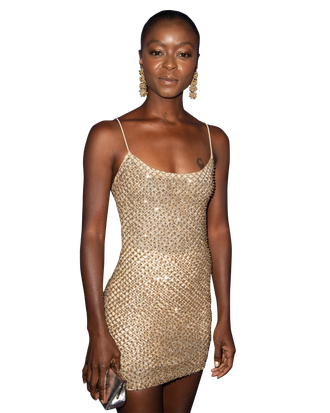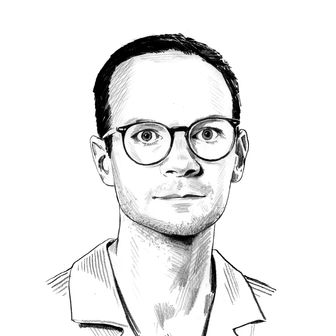
This interview discusses the events of the Station Eleven finale.
The thing that unites the pre- and post-apocalypse stories in Station Eleven is a graphic novel, itself titled Station Eleven, written by Miranda Carroll (Danielle Deadwyler) that becomes an accidental guide to surviving incredible trauma. Before the Georgia Flu sweeps over the world, Miranda has a job in logistics but spends her free time writing Station Eleven — to the point of alienating her star actor husband (and later, ex) Arthur (Gael García Bernal). Hours after learning of Arthur’s unexpected onstage death, Miranda herself dies when the flu hits during her work trip to Malaysia, and her story makes up a large part of the third episode of the HBO Max series. But in its finale, Station Eleven returns to Miranda’s final moments in her hotel room. There, she gets gets a call from Clark, Arthur’s friend, who has managed to hole up at an airport in Michigan on his way to collect Arthur’s body from Chicago.
Miranda decides to help Clark from all the way across the world by calling a pilot who has landed at the airport and convincing him to keep his likely infected passengers from exiting the plane. She also reveals that losing her family during Hurricane Hugo fueled her work on Station Eleven. Deadwyler plays Miranda’s final moments with a heartbreaking, calm intensity, though speaking with Vulture in person, she was happy to crack jokes. Talking over Zoom, she discussed how Miranda’s backstory informed her performance and how she thinks about TV acting in relation to her own performance art.
In the finale, the show introduces the story of Miranda’s family, who died in Hurricane Hugo. Did you know her history when you first started playing the part?
I think I knew everything. I read the book, and obviously we deterred from it a little bit, but there was hella backstory available to me. There was stuff that me, showrunner Patrick Somerville, and director Hiro Murai developed along the way as well. But then I had a whole year in between shooting my first episode — the unintentional break of the pandemic — and coming back in March 2021 to shoot episode ten.
What did you want to know when you were filling out her backstory?
I was pulling from a lot of different things. I was reading a lot of poetry. I was hyperaware, when we started January 2020, that COVID was a thing. So the nature of a survivalist was a really interesting thing, let alone someone who was defining themselves as a non-artist artist. Miranda was intuitively creating for her own survival. Everything was available in the script, but I was trying to hone what her timeline was. How does a person come to be the kind of survivalist that she is and the kind of loner that she is? I think that’s someone we fear. I think it’s something we feared in the pandemic. People have been resistant to being quiet, to being alone, with the nuclear family and the self. Miranda was dealing with that pre-pandemic, so she’s an anomaly.
In the finale, Miranda makes a call to this pilot to say that he’s going to have to make a decision that goes against all his instincts — to save the people at the airport by not letting his passengers get off the plane. How did you think about playing that scene?
You don’t think! Because she’s come full circle, in that way, because it’s not about her. It’s not always about her. I have the capacity to take the last vestiges of my energy to express a deep, profound, unselfish love and enable others to thrive and create and do something beyond survival. It was a crazy place to be in. I sat for two weeks in Toronto by myself in quarantine. I had a lot of time to reckon with it. We had a full year in the COVID pandemic to look at the ramifications of not caring and not being a community member and witnessing the deaths. Miranda hadn’t seen the deaths, but she had been doing what her Spidey senses were telling her to do, to get out on her own. But no, it’s not about that, especially in this moment when I know that I am succumbing. It’s a deep love to think of Clark, to tell him you can do more and you can do better.
Miranda also has these visions of seeing Dr. Eleven, the spaceman who’s central to her work and appears throughout the show. What was it like to play those encounters?
Strange and profound. You’re looking into the shield, and it’s this warped kind of expansion, like, “rethink yourself.” Dr. Eleven is the conscientious observer, an imaginary friend, and so many other things. It’s just weird! But it was beautiful to come out into the great expanse in a scene where Miranda imagines watching the Earth from space with Dr. Eleven. It’s a portal, a liminal space to get you to where you really want to be, some kind of ecstatic paradise. Which is where she gets to.
In the pre-pandemic scenes, Miranda’s split between this logistics career, her secret obsession with this book, and her relationship with Arthur. How did you approach those divided aspects of her?
She’s tightly woven in that she’s trying to protect that thing. I know what it feels like, and I think a lot of artists know what it feels like. Patrick said it feels like two relationships when you’re in a relationship with somebody and then you have this art. There was a great joy that Arthur brought to Miranda. There was no coddling of the chaos she was existing in and expressing, and he appreciated that. When somebody does that, they blow your fucking mind, and you yield a bit, but whatever’s at your root is still trying to come out, which is what Station Eleven the graphic novel was for her. Gael’s great and has everything that makes Arthur so compelling as an entity, but they’re working in two different artistic paths.
Miranda releases a lot of coiled energy in that scene at the dinner party in episode three, where she turns on Arthur after discovering he’s let Elizabeth read some of her work. She gives a toast quoting one of his movies and then turns over a glass of wine. How’d it feel to let all that out?
My heart was beating really fast. I think they called for quiet on the set, and someone was like, “I can hear a beating?” And it was me! But that’s how it gets when somebody violates that kind of privacy. Oooh, yeah, you’re gonna burn the fucking pool house down. That’s a survivalist action, the most interior kind of survivalist action. It’s different from “let me protect the flesh.” It’s “let me protect the self, let me protect the spirit.” A lot of women like that wine scene, and they want to do that. When someone makes you, down to your core, feel that way, you want to throw the damn glass all around. It was volcanic.
In addition to your film and TV work, you make your own performance art and visual art. Do you relate on that level to Miranda’s own sense of needing that side of herself?
I do. Everything I do is deeply, deeply, deeply personal and not to come out until it’s ready to come out. I know a lot of people who work in visual art, and we hold it to the body a bit more, because it’s not necessarily as collaborative as TV and film and theater. There, you want options, you want to see where the holes are. Visual art is different. Performance art is different. You can’t have people nitpicking at what you’re creating — not that TV, film, and theater aren’t personal, but every medium has a different approach. I identify with Miranda. But the difference in myself is that I care about the aftermath a lot more, about the care and longevity and perpetuity of a project. She’s just like, I made this book, I’m giving it to these people, and I’m finished, like an amends-making. I have to do more than that. There’s a specificity to how and to whom this is being presented. There’s a conversation in the art world about who is collecting one’s work and how you navigate how the artist is cared for after. Those are significant things that I carry forth and learned from peers of mine.
I read an interview you did where you said you were interested in appreciating what the commercial and experimental art-making worlds can learn from each other. What do you think you learned on Station Eleven?
You can be strange. Everybody doesn’t necessarily get Station Eleven, but I don’t know if you necessarily have to. Everything doesn’t have to be understood. You’re not allowed every quality of a human being. I think that’s something important to fuse and understand, between both sides. I think we always presume “commercial” means “accessible” and that “experimental” is “not accessible.” There may be a small number of pieces that you might get, but that doesn’t mean you haven’t been invited to see them. I think everybody is invited to either, but the question is “Do you want to come in?”
What was the last scene that you filmed as Miranda? She’s such a charged, isolated character — I was wondering how you said good-bye to her.
It was the beach. It was a lot of takes of climbing out of the tunnel and stepping onto the sand and that joy. It’s a spiritual joy that she comes to. It was a great release. It felt remarkable because it wasn’t a burden but something you carry with purpose. Once you are able to loosen, it’s nice.





